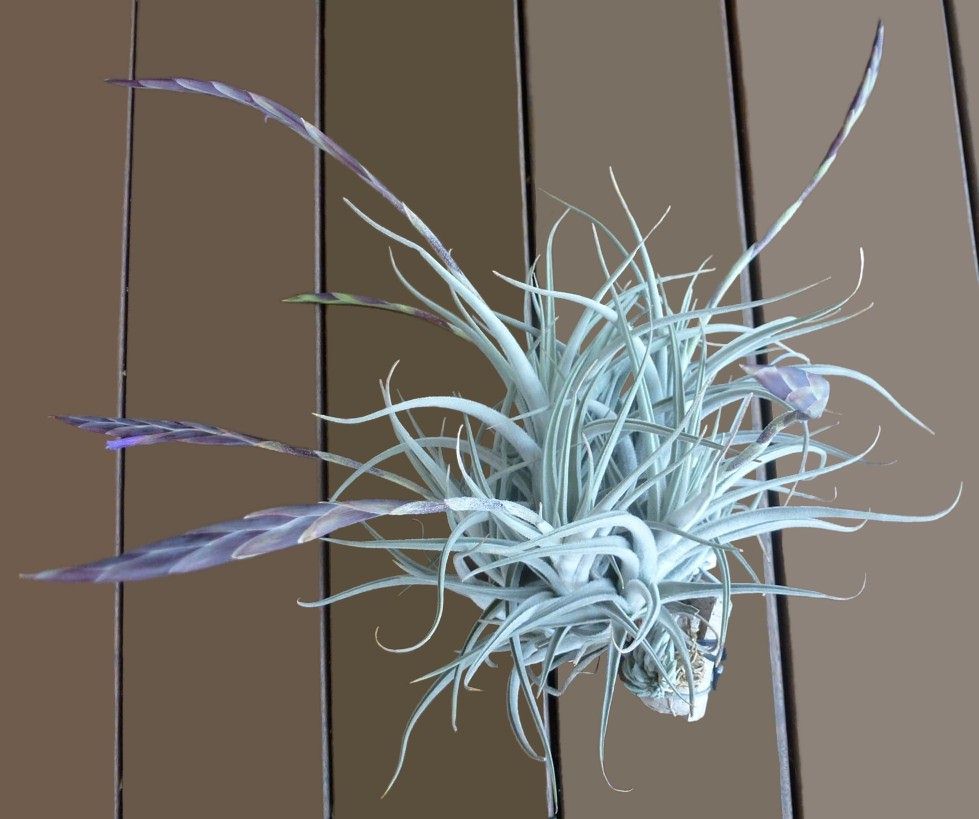


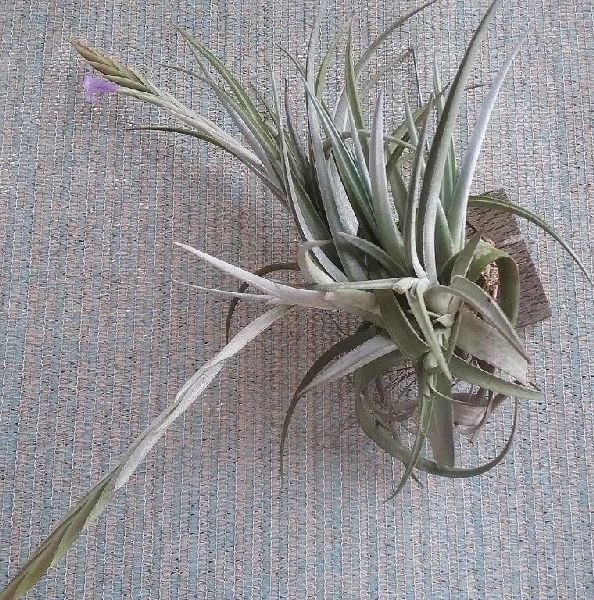


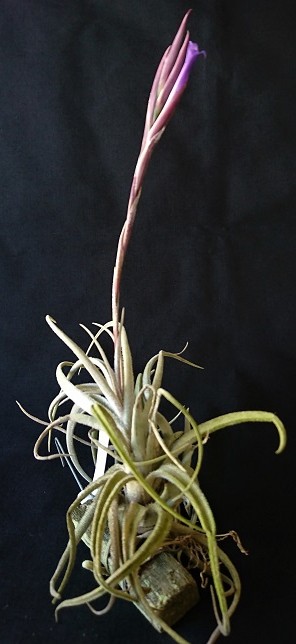
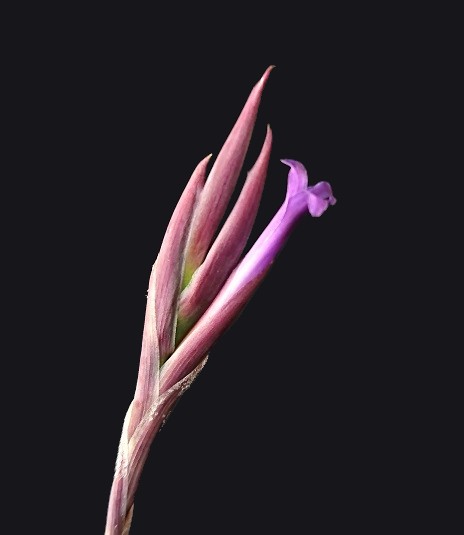
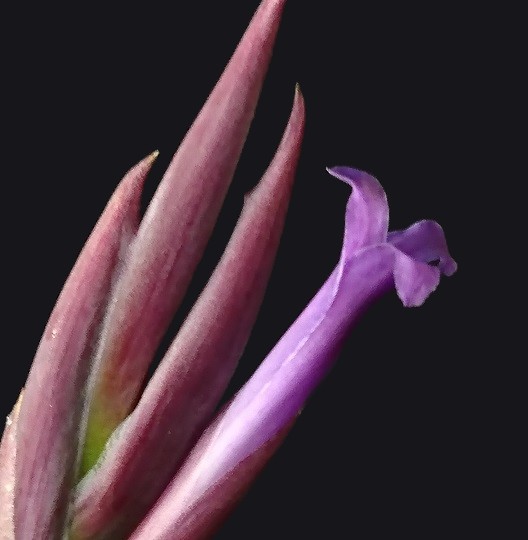
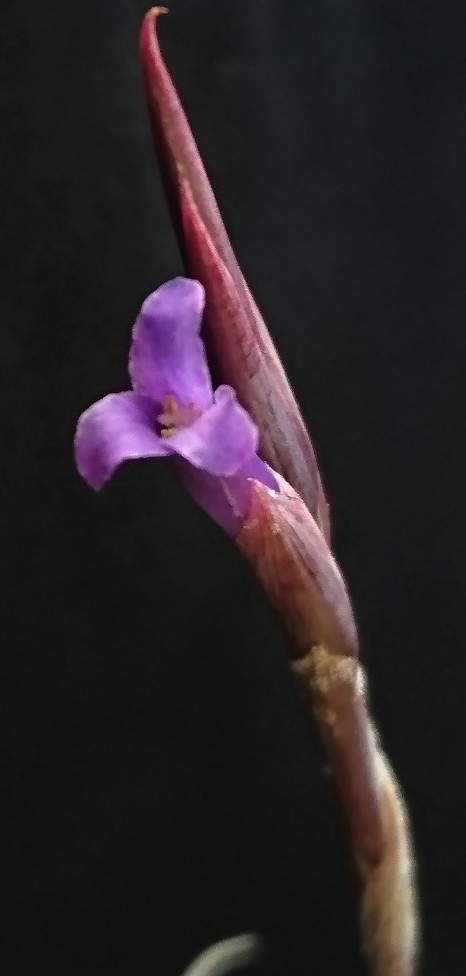

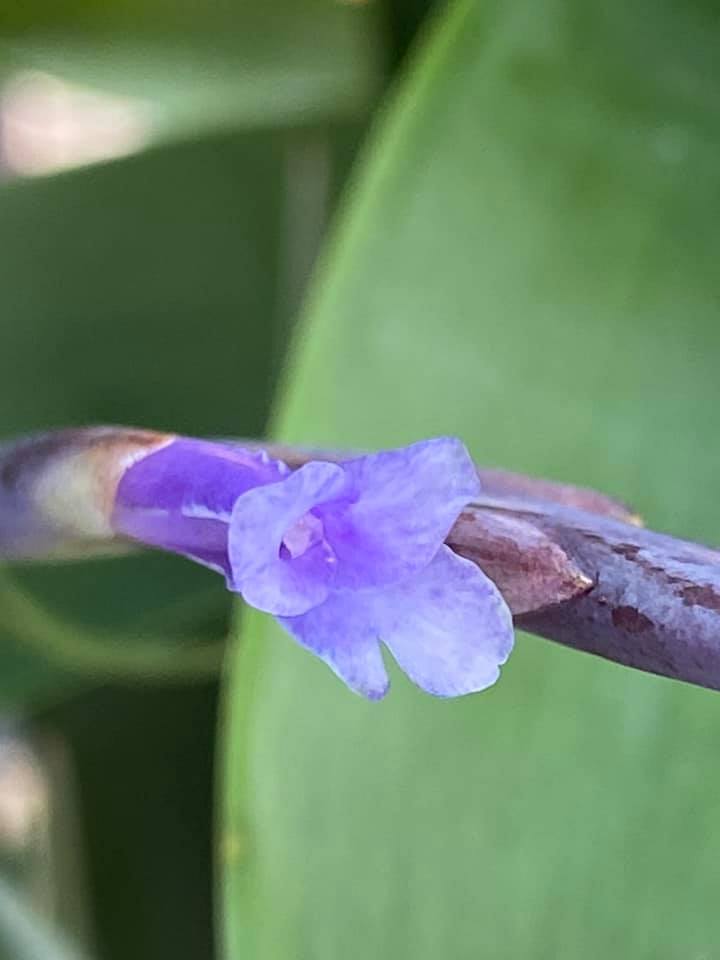
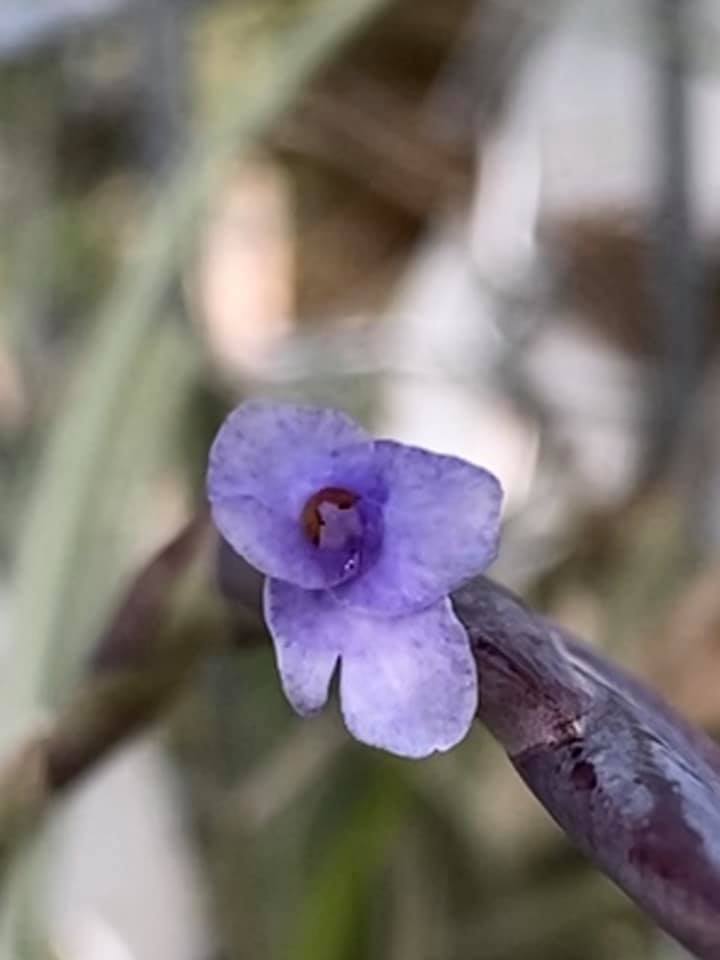
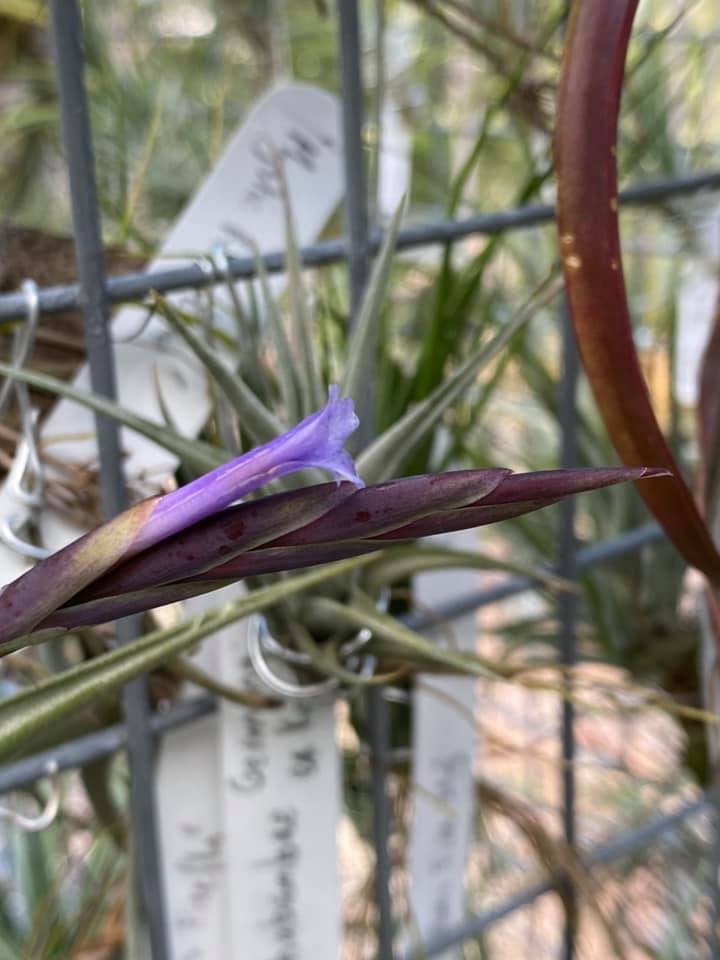
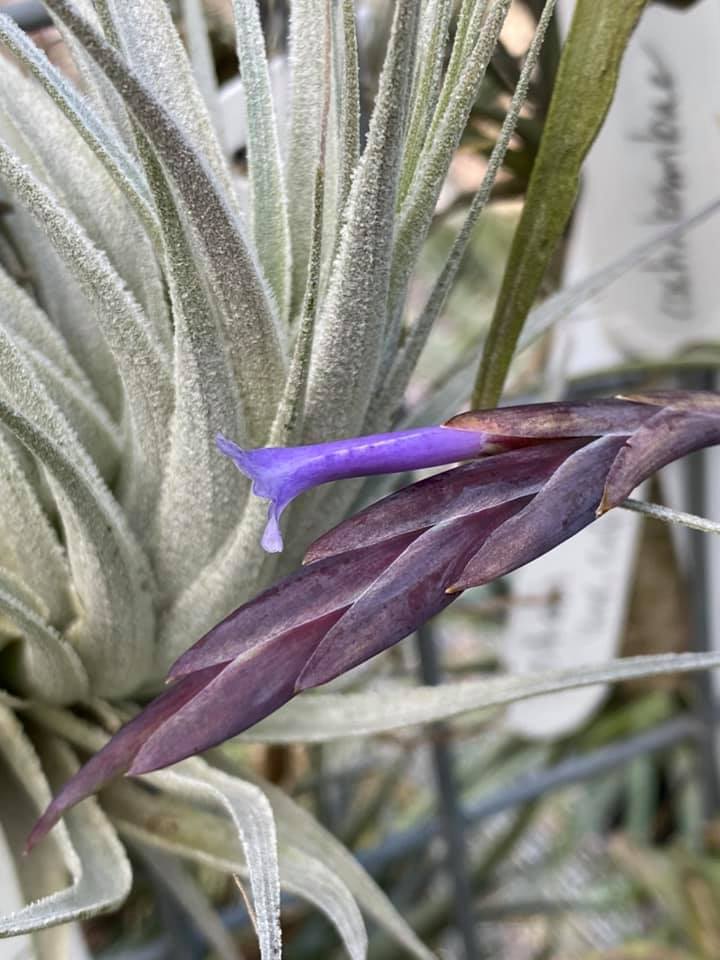
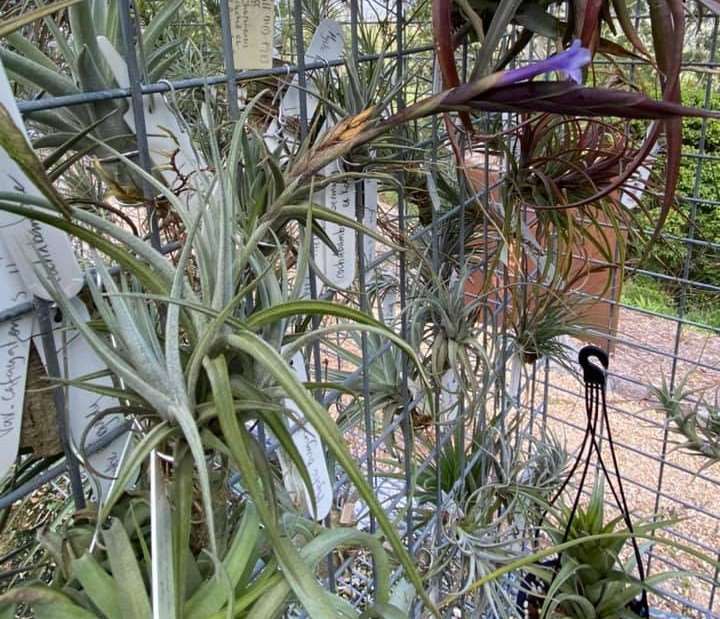
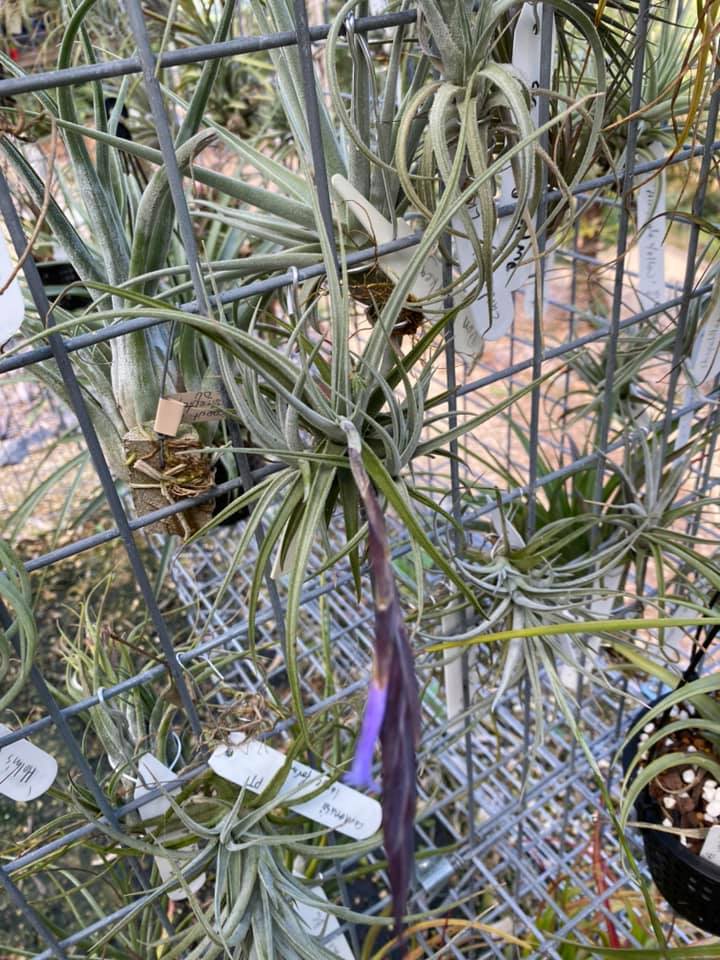

Plant short stemmed, flowering 20-25 cm long; stem to 10 cm long, simple;
Leaf erect or almost erect, only the lowermost more or less reflexed, densely polystichous, to 20 cm long;
Sheath (oval, 5 mm long, glabrous, papery), triangular, at the base 25 mm wide, virtually enclosing the stem, inside 15 mm glabrous, outside 5 mm, with exception of the glabrous part, smooth, papery side wings strongly parallel nerved, quickly narrowing;
Blades narrowly triangular, 8 mm wide, tapering to a long, thin tip, covered with dense matted (ash grey), silvery basal sessile scales, strongly grooved, inside abundantly furrowed;
Scape somewhat exceeding the leaves, erect to bent over, At anthesis 2 mm thick, 1 mm when dry, furrowed with parallel long stripes, glabrous;
Scape bracts lanceolate, long as the internodes, with dark purple sheaths, inside glabrous, outside more or less densely appressed scaled, the lowermost with blades like the leaves, the uppermost similar to the floral bracts;
Inflorescence somewhat exceeding the leaves, mostly simple, rarely with a short, adjacent side spike, (4-7-flowered), to about l1-flowered, lanceolate, very flat complanate, (5 cm long) to 7 cm long, 1 cm wide;
Floral bracts like the scape bracts, but glabrous, densely imbricate, but the rhachis not totally covered, with a leathery ridge almost membranous, not keeled, 20 to 27 mm long, to 10 mm wide, lanceolate, acuminate, exceeding the sepals, dark violet; Internodes 6-8 mm long; Rhachis almost erect, biconcave, green, glabrous;
Flowers almost sessile, to 35 mm long;
Sepals lanceolate, acuminate, to 20 mm long, (free), the posterior pair keeled and 3-4 mm connate, glabrous, smooth, first postfloral nerved;
Petals (tongue-shaped) spatulate, 35 mm long, 2-3 mm wide, extended, later rolled back, lilac, in the lower part covered by the sepal white;
Stamens (approximately as long as) somewhat shorter thant the pistil, somewhat shorter than the petals and visible above the flower tube;
anthers 3 mm long, filiform, greenish, basifixed, pollen yellow; stigma with clearly extended white lobes;
Capsule cylindrical, short tipped, about as long as the floral bracts.
Type: Cerro Macho near Tomina, 2730m, Chuquisaca, Bolivia; Cardenas 491, Apr, 1933.
Collection from type locality: 22. 7. 1977, leg. H.& L.Hromradnik HR 3082.
Further living material of T. cardenasii examined:
Dept. Chuquisaca: east of Tarabuco, 2700 m, 9. 7. 1982, leg. H. Hromradnik, HR 9014, (WU); south of Sucre, 2600 m, 18. 7. 1979, leg. H & L. Hromradnik, HR 5044, (WU);
Dept. Cochabamba: east of Cochabamba, 2850 m, 16. 7. 1977, leg. H & L Hromradnik, HR 3014; Omereque, 1600 m, 15. 2. 1995, leg. L. Hromradnik, HR 19068, (WU);
Dept. Potosi: Rio Mataca, 2700 m, 11. 3. 1999, leg. L. Hromradnik HR 24058 (WU).
Ti11andsia cardenasii L. B. Smith, Proc. Am. Acad. (Contr. Gray Herb. 106) 70: 154, 167,pl. 3,figs. 5, 6. 1935.
Desc from S&D p794
Plant caulescent, flowering 20-25 cm high; stem to 1 dm long, simple.
Leaves erect or suberect, densely polystichous, to 2 dm long;
Sheaths ovate, 5 mm long, glabrous, char¬taceous;
Blades linear-triangular, filiform-acuminate, 8 mm wide, densely villous-lepidote with basally produced cinereous scales, involute.
Scape erect, 1 mm in diameter, glabrous, sulcate;
Scape-bracts lanceolate, exceeding the internodes, dark purple, appressed-¬lepidote, the lowest foliaceous-laminate.
Inflorescence slightly exceeded by the leaves, simple, densely 4-7-flowered, lanceolate, complanate, 5 cm long, 1 cm wide.
Floral bracts like those of the scape but glabrous, densely imbricate, submembranaceous, not at all carinate, to 27 mm long, exceeding the sepals;
Flowers subsessile.
Sepals free, lanceolate, acuminate, to 20 mm long, glabrous, nerved;
Petals ligulate, lilac;
Stamens about equaling the style, slightly shorter than the petals.
Capsule cylindric, short-beaked, about equaling the floral bracts.
Type. Cardenas 491 (holotype GH), rocky places, Cerro Macho, 2730 m alt, Chuquisaca, Bolivia, Apr 1933.
DISTRIBUTION. Known from the type collection only.
T. cardenasii L. B. Smith var. major Ehlers & L. Hrom., Die Brom. 1: 19-23. 2005.
A Tillandsia zecheri W Till, cui similis, habitu majori, scapo elongato, inflorescentia pler-umque composita, bracteis scapi atroviola¬ceis, spicis latioribus, internodiis rhachidis multo brevioribus et bracteis florigeris atroviolaceis brevioribusque differt.
Typus: Bolivia, Dept. Chuquisaca, Distr. Oropeza, in rupibus arduis vallis lateralis fluminis Rio Chico prope Chuqui-Chuqui, 1900 m s. m., leg. L. Hromadnik HR 19065, 12. 3. 1995 (Holotypus LPB, Isotypus WU); R. Ehlers EB 951905 (Paratypus WU), R. Ehlers EB 991704, L. Hromadnik HR 24061, leg. 13. 3. 1999 (Paratypus WU).
Plant singularly or in small groups with strongly branched, large root stock, growing on vertical rocks, with clearly penetrating rhizome or short strong stem, that is hidden by the overhanging lower leaves;
flowering 25-40 cm high; rosette erect, extending narrowly, 10-15 cm in diameter, with not very many leaves ( maximum 20-25);
Leaf polystichous, densely imbricate, to 22 cm long, thick leathery, stiff, both sides dense grey white lepidote, underneath dense felt with silvery white, eccentric scales, the edges with long ciliate trichomes;
Sheath erect, enclosing the stem, to 35 mm wide, 25 mm high, triangular at the base, glabrous on inside for 15 mm, outside at the edges for 5 mm, inconspicuously merges into the blade;
Blade narrowly triangular, to 25 mm wide and about 18 cm long, tapering to a awl-like tip, the upper ones stiff erect or somewhat spreading, the bottom ones totally bent over, grooved, underneath weakly asymmetric keeled;
Scape shorter than the leaves, 5-15 cm long, 4-5 mm diameter, erect, glabrous, green, covered with a few lepidote, densely imbricate scape bracts;
Scape bracts with 4-5 cm long, 12 mm wide sheath, the base with the exception of a nerved glabrous base the outside densely lepidote and with to 6 cm long narrow blade, similar to the inner rosette leaves; the upper dark red, tipped and dense scattered appressed lepidote, similar to the primary bract;
Inflorescence exceeding the leaf-rosette, almost erect or slightly bent over, 9-18 cm long; a simple distichous sword shape or densely bipinnate with up to 5 digitate erect spikes;
Primary bract to 4 cm long, 1,5 cm wide, oval acuminate, violet-black, densely lepidote;
Spike densely distichous, strongly complanate, tip lanceolate, 6-12 cm long, (the terminal spike mostly larger), to 20 mm wide, with 7-15 flowers and rarely 1 sterile bract at the base;
Rhachis almost straight, green, 4 angled, biconcave, glabrous; Internodes 7-8 mm;
Flowers to 45 ( 50) mm long, erect, almost sessile, scentless;
Floral bracts densely imbricate, but leaving the rhachis at the time of the anthesis somewhat visible, (14 -) 28-35 mm long, 10-12 mm wide, exceeding the sepals by about 2-3 mm, narrowly elliptic, acuminate, thick leathery and stiff, glabrous, not keeled or only the upper part clearly keeled, the base double keeled, inside strongly nerved and greenish, outside weakly nerved and shiny violet-black, waxy overlay;
Sepals 12-28 mm long, above the base to 7 mm wide, tip lanceolate, anterior 2 mm, the posterior pair 3 mm connate with the ovary and keeled, glabrous, smooth, leathery, the bottom 3 mm greenish, above wine-red;
Petals tongue-shaped, 35-45 mm long, the part covered by the sepals white, 4 mm wide at the base, the upper part to 5 mm wide, violet, the edges finely waved, the blunted, quite weakly small toothed tips bent strongly outwards;
Stamens enclosed in the floral tube, Style somewhat protruding;
anthers and stigma visible at the base of the corolla, Filamente white, narrow ribbon like, double folded, 20-25 mm long, anthers 4-5 mm long, 0,5 mm wide, linear acuminate, basifixed, ochre coloured, pollen lemon-yellow;
Style 2.5-3 cm long, at the base 0,8 mm diameter, narrowing towards the top, white, yellowish toward the tip;
stigma 2 mm long, 3,5 mm wide, the slender lobes very strongly spreading, papillose, yellowish, Type I Brown & Gilmartin (1984);
Ovary oval, 6 mm high, 2,5 mm thick, yellow green.
Type: Bolivia, Dept. Chuquisaca, Distr. Oropeza, canyon walls in a side-valley of the Rio Chico with Chuqui-Chuqui, 1900 m.s.m.
Habitat and Range: until now the variety is only know from the type locality where it grows with a very beautiful compact form of T. xiphioides Ker Gawler on vertical cliffs in a narrow canyon where it was first found by the authors with Ewald Heger and F. J. Hase in 1995.
Vegetatively, this plant with its satin like white leaves is similar to T. zecheri var. zecheri W. Till, but differs from this by the larger growth, the usually much longer scape, the abundant compound inflorescence, the dark-violet colour of the scape bracts, the wider spike, the much shorter rhachis internodes, and the shorter likewise dark violet floral bracts (with T. zecheri dark pink).
It also differs from T. lorentziana Gris. in several characteristics: the leaf is more broadly triangular, stiff, with awl-like tip and dense, silvery white, eccentric scales (T. lorentziana concentric, grey or brownish, see Smith & Downs 1977); the scape is shorter and stocky, the inflorescence dark-violet and, if compound, then not lax but densely digitate with up to 5 broad and mostly long erect spikes; sterile base of the spike very short or missing; the floral bracts are much longer, thick leathery and stiff, shiny black-violet with a somewhat waxy overlay, well exceeding the sepals, the sepals long and leathery; petals usually longer and dark violet, not white or blue, almost linear without elliptical platte, the edges finely waved and minutely toothed, much stronger bent outwards.
The dark-violet colour of the entire inflorescence including the scape bracts is identical to T. cardenasii and typical for this species. Also it agrees in the form and colour of the flower, but is clearly our plant is larger in habit and inflorescence as well as the stem; the rosette is more compact, the leaves are much bigger and broader, the spike up to twice as wide; floral bracts are leathery and often keeled, petals much larger, the edges finely waved, and minutely toothed, more strongly bent outwards.
To get a better demarcation of the new variety of the stemmed T. cardenasii var. cardenasii the following is an amendment of the original diagnosis by Smith on the basis of examinations of living plants collected at the Type locality.
T. cardenasii, Tomina, Cerro Macho HR3082:
Plant short stemmed, flowering 20-25 cm long; stem to 10 cm long, simple;
Leaf erect or almost erect, only the lowermost more or less reflexed, densely polystichous, to 20 cm long;
Sheath (oval, 5 mm long, glabrous, papery), triangular, at the base 25 mm wide, virtually enclosing the stem, inside 15 mm glabrous, outside 5 mm, with exception of the glabrous part, smooth, papery side wings strongly parallel nerved, quickly narrowing;
Blades narrowly triangular, 8 mm wide, tapering to a long, thin tip, covered with dense matted (ash grey), silvery basal sessile scales, strongly grooved, inside abundantly furrowed;
Scape somewhat exceeding the leaves, erect to bent over, At anthesis 2 mm thick, 1 mm when dry, furrowed with parallel long stripes, glabrous;
Scape bracts lanceolate, long as the internodes, with dark purple sheaths, inside glabrous, outside more or less densely appressed scaled, the lowermost with blades like the leaves, the uppermost similar to the floral bracts;
Inflorescence somewhat exceeding the leaves, mostly simple, rarely with a short, adjacent side spike, (4-7-flowered), to about l1-flowered, lanceolate, very flat complanate, (5 cm long) to 7 cm long, 1 cm wide;
Floral bracts like the scape bracts, but glabrous, densely imbricate, but the rhachis not totally covered, with a leathery ridge almost membranous, not keeled, 20 to 27 mm long, to 10 mm wide, lanceolate, acuminate, exceeding the sepals, dark violet; Internodes 6-8 mm long; Rhachis almost erect, biconcave, green, glabrous;
Flowers almost sessile, to 35 mm long;
Sepals lanceolate, acuminate, to 20 mm long, (free), the posterior pair keeled and 3-4 mm connate, glabrous, smooth, first postfloral nerved;
Petals (tongue-shaped) spatulate, 35 mm long, 2-3 mm wide, extended, later rolled back, lilac, in the lower part covered by the sepal white;
Stamens (approximately as long as) somewhat shorter thant the pistil, somewhat shorter tha the petals and visible above the flower tube; anthers 3 mm long, filiform, greenish, basifixed, pollen yellow; stigma with clearly extended white lobes;
Capsule cylindrical, short tipped, about as long as the floral bracts.
Type: Cerro Macho near Tomina, 2730m, Chuquisaca, Bolivia; Cardenas 491, Apr, 1933.
Collection from type locality: 22. 7. 1977, leg. H.& L.Hromradnik HR 3082.
Further living material of T. cardenasii examined:
Dept. Chuquisaca: east of Tarabuco, 2700 m, 9. 7. 1982, leg. H. Hromradnik, HR 9014, (WU); south of Sucre, 2600 m, 18. 7. 1979, leg. H & L. Hromradnik, HR 5044, (WU);
Dept. Cochabamba: east of Cochabamba, 2850 m, 16. 7. 1977, leg. H & L Hromradnik, HR 3014; Omereque, 1600 m, 15. 2. 1995, leg. L. Hromradnik, HR 19068, (WU);
Dept. Potosi: Rio Mataca, 2700 m, 11. 3. 1999, leg. L. Hromradnik HR 24058 (WU).
T. cardenasii is wide spread in Bolivia. Its southernmost occurrence lies in the valley of the Rio Mataca, Dept. Potosi, its northernmost occurs in the vicinity of the city Cochabamba. It is most common near Sucre and east of it (Type locality!), in fact mostly between 2100 m and 3000 m. All of the plants from the type locality hardly show any deviation in their characteristics, and this includes those from extreme situated places of discovery (as at Omereque, 1600 m, Dept. Cochabamba).
Only the smaller, somewhat controversial T. pseudocardenasii Weber differs from the others by being more delicate in habit through its much shorter and narrower, mostly secund upward bent leaves. But its floral features decidedly lies within the broad framework of the normal variability puts its status as a separate species in very much doubt.
Its occurrence seems to be confined to one single rock face west of Ortes Comarapa, Dept. Comarapa.
Examined material from the type collection of T. pseudocardenasii:
Cochabamba, west of. Comarapa, 2300 m, 18. 7. 1977, leg. H & L Hromradnik, HR 3040, (Paratype, WU); same locality, 6. 8. 1979, leg. H & L Hromradnik HR 5323, (Isotype, WU).
Further examined material: same locality 18. 2. 1995, leg. R Ehlers, EB 951505, (WU); 20.3.1999, EB 992501(WU).